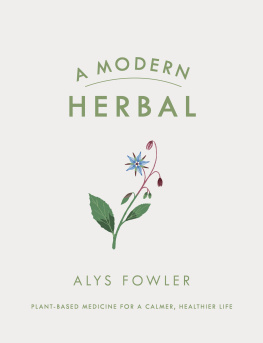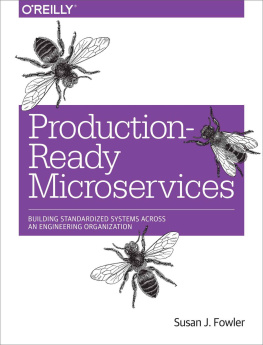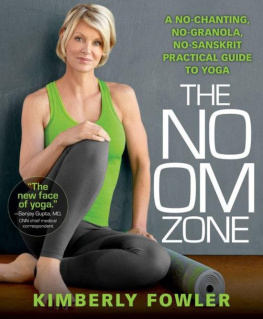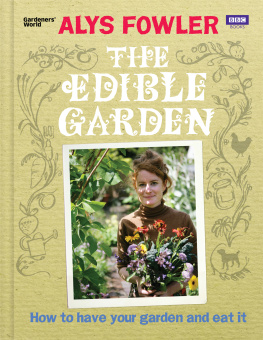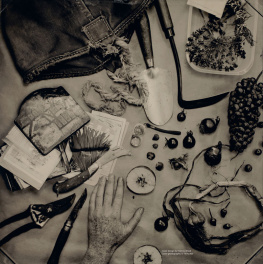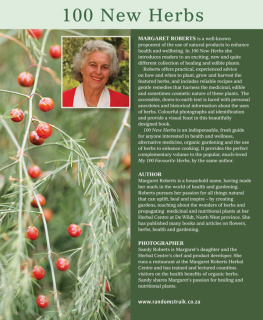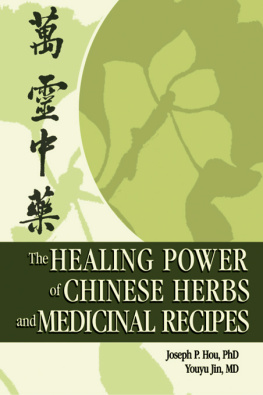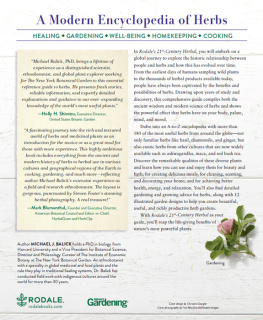Alys Fowler
A MODERN HERBAL

PENGUIN BOOKS
UK | USA | Canada | Ireland | Australia
India | New Zealand | South Africa
Penguin Books is part of the Penguin Random House group of companies whose addresses can be found at global.penguinrandomhouse.com

First published 2019
Copyright Alys Fowler, 2019
The moral right of the author has been asserted
ISBN: 978-0-241-36836-7
This ebook is copyright material and must not be copied, reproduced, transferred, distributed, leased, licensed or publicly performed or used in any way except as specifically permitted in writing by the publishers, as allowed under the terms and conditions under which it was purchased or as strictly permitted by applicable copyright law. Any unauthorized distribution or use of this text may be a direct infringement of the authors and publishers rights and those responsible may be liable in law accordingly.
Disclaimer
The information in this book is for educational purposes, and is written to inform readers about traditional remedies and methods in herbal medicine from around the world and to teach them to grow some of these plants in their gardens. It is not a replacement for professional medical advice. Many herbs are considered unsafe for pregnant women. Where possible, I have indicated these in the text, but whether youre using a remedy from this book or from any other sources, contact your midwife, doctor or a herbalist first if you are trying to conceive, or are pregnant or breastfeeding.
Likewise, if you are on any medication, prescribed or not, seek advice before you supplement or add home remedies. Finally do not use any remedies on children under two without checking with a herbalist or healthcare practitioner first.
Preparation of Herbs
Herbs are wonderful things, bringing in pollinators and beneficial insects, adding their notes of beauty to your garden, swaying in the wind and all that, but if you are to make the most of them, then you will have to pick and process them. Even if thats as simple as plucking a plantain leaf, chewing it up and spitting it out on to an insect bite or nettle sting. The wonder of herbs does not happen merely by looking at them.
Each herb has its moment when it needs to be picked. A camomile plant is not much use until it is in flower, and even then there is an art to when to pick the flowers so that they are open but dont immediately shatter on drying. There are nuances to all of these herbs and the truth is that experience is far more important than rules. You will learn when you process herbs that all plants are individuals responding to their environment and your growing techniques differently, and therefore you have to cut and pluck and pick with all your senses awake and alert. Look for moulds under leaves, look for damage and insects, note how the sun or shade affects the smell, feel, texture, thickness and taste of the plant. With careful observation you will quickly learn how and when you need to pick from your garden and how quickly you have to respond to changing weather. This is part of the tradition of using herbs, to have a knowledge that is specific to your place in the world and using that over any rule about this or that.
Drying herbs
Most fresh herbs contain around about 6085 per cent water. Roots and rhizomes have a larger proportion of dry matter than leaves and flowers. By the time a herb has been successfully dried it should contain somewhere between 810 per cent water, though this can vary. You want the leaves to be dry enough that they dont turn mouldy, but not so dry that they are brittle and break when handled. This may mean experimenting around your house to find a place that is dry, warm and airy to dry the herbs quickly enough that you can achieve this. Kitchens, airing cupboards, above the fridge (which is always warm from the cooling system behind it) or near it are ideal. On top of the radiator doesnt work because of the swing of temperature.
One solution is to make or buy a herb-drying rack that can be suspended somewhere warm and airy. These are often made of material such as mesh frames and offer several shelves on which to dry. When not in use they are easily stacked for storage. If the summer is being kind and the weather is hot, then drying outside is often the perfect solution. You may need to cover your set-up with mesh netting to keep insects away, and all herbs should always be dried away from direct sunlight as the volatile oils in them are often easily destroyed by direct heat. If you find that you are processing a lot of herbs, then a dehydrator is invaluable. This will dry your herbs at a regulated temperature of 35C/95F. You can dry herbs at up to 46C/115F, and roots can be dried at up to 65C/150F.
If you are tying herbs in bundles to suspend from a hanger, make sure the bundles have sufficient space between them so that air can circulate. One solution is to create an indoor clothes line for your herbs and, using pegs, attach them individually to dry.
Your herbs are ready for storage when they feel paper-dry and they rustle. Under gentle pressure they will break up, but theyre not brittle at a mere touch. Stems should not bend; if you squeeze the material gently and it reforms, there is still too much moisture.
Once dry your herbs need to be stored in an airtight container and kept out of direct sun. Some herbs, such as hops, will need to be kept in the fridge to maintain their properties, and no herb should be kept for such a long time that you cant remember when you picked it. As with all preserving techniques, date the container. If you do this, you can also start to monitor how much of a certain herb you need. If youve still got most of last years supply, then you need to either grow or process less. If youve run out by December of a September harvest, you need to up your growing game. Of course, you can also go and buy dried herbs there are plenty of reputable growers and suppliers.
If you have found that you didnt dry your herb sufficiently and they smell slightly mouldy, or you can see mould, then bin them rather than trying to re-dry them. The moulds that form on plant material are not necessarily harmful, but they are not something you need to drink or ingest.
Infusions and decoctions
How to make a cup of herbal tea
I never thought Id write this, but there turns out to be a right and a very wrong way to make herbal tea. Our grandmothers made tea properly in a pot; we, the children of convenience and mass-produced teabags, make tea terribly, and its nothing to do with how strong it looks. Its about capturing the volatile oils that do all the magical stuff.
There are two types of tea for herbs, an infusion or a decoction. Decoction refers to gently simmering your herbs in boiling water, and tends to be used with material that is tougher, such as roots, barks and seeds. An infusion is simply a cup of tea made by steeping the leaves, flowers and non-woody parts of the plant in either hot or cold water.
You can use fresh or dried herbs. Tear or cut up whole leaves to open the cell structures and release the chemical constituents. You will, however, have to use a greater volume of fresh herbs than dried to compensate for the higher water content. If you find instructions calling for one part dried herbs, say 1 teaspoon, then you will need to use three parts fresh herbs, as in 3 teaspoons. Or, put another way, 1 teaspoon of dried herbs equals 1 tablespoon of fresh. The truth of the matter is that a teaspoon can vary vastly depending on whether you crush, grind or chop the herb, but in weight terms you are looking for 1g of dried herbs or 3g of fresh herbs in a cup of water, which for ease I have made 250ml, because, lets face it, everyones cups are slightly different.

